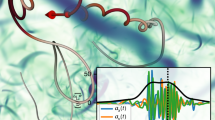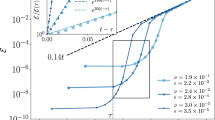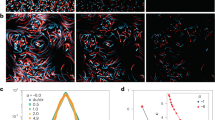Abstract
It may come as a surprise that a phenomenon as ubiquitous and prominent as the transition from laminar to turbulent flow has resisted combined efforts by physicists, engineers and mathematicians, and remained unresolved for almost one and a half centuries. In recent years, various studies have proposed analogies to directed percolation, a well-known universality class in statistical mechanics, which describes a non-equilibrium phase transition from a fluctuating active phase into an absorbing state. It is this unlikely relation between the multiscale, high-dimensional dynamics that signify the transition process in virtually all flows of practical relevance, and the arguably most basic non-equilibrium phase transition, that so far has mainly been the subject of model studies, which I review in this Perspective.
This is a preview of subscription content, access via your institution
Access options
Access Nature and 54 other Nature Portfolio journals
Get Nature+, our best-value online-access subscription
$29.99 / 30 days
cancel any time
Subscribe to this journal
Receive 12 digital issues and online access to articles
$99.00 per year
only $8.25 per issue
Buy this article
- Purchase on Springer Link
- Instant access to full article PDF
Prices may be subject to local taxes which are calculated during checkout






Similar content being viewed by others
References
Reynolds, O. An experimental investigation of the circumstances which determine whether the motion of water shall be direct or sinuous, and of the law of resistance in parallel channels. Proc. R. Soc. Lond. 35, 84–99 (1883).
Rayleigh, L. On the convective currents in a horizontal layer of fluid when the higher temperature is on the under side. Philos. Mag. 32, 529–546 (1916).
Taylor, G. I. Stability of a viscous liquid contained between two rotating cylinders. Proc. R. Soc. Lond. A 223, 289–343 (1923).
Chandrasekhar, S. Hydrodynamic and Hydromagnetic Stability (Oxford Univ. Press, 1961).
Drazin, P. G. & Reid, W. H. Hydrodynamic Stability (Cambridge Univ. Press, 2004).
Meseguer, A. & Trefethen, L. N. Linearized pipe flow to Reynolds number 107. J. Comput. Phys. 186, 178–197 (2003).
Pomeau, Y. Front motion, metastability and subcritical bifurcations in hydrodynamics. Phys. D 23, 3–11 (1986).
Avila, K. et al. The onset of turbulence in pipe flow. Science 333, 192–196 (2011).
Pfenninger, W. in Boundary Layer and Flow Control (ed. Lachman, G. V.) 970 (Pergamon, 1961).
Mukund, V. & Hof, B. The critical point of the transition to turbulence in pipe flow. J. Fluid Mech. 839, 76–94 (2018).
Coles, D. Transition in circular Couette flow. J. Fluid Mech. 21, 385–425 (1965).
Prigent, A., Grégoire, G., Chaté, H., Dauchot, O. & van Saarloos, W. Large-scale finite-wavelength modulation within turbulent shear flows. Phys. Rev. Lett. 89, 14501 (2002).
Tuckerman, L. S., Chantry, M. & Barkley, D. Patterns in wall-bounded shear flows. Annu. Rev. Fluid Mech. 52, 343–367 (2020).
Kaneko, K. Spatiotemporal intermittency in coupled map lattices. Prog. Theor. Phys. 74, 1033–1044 (1985).
Chate, H. & Manneville, P. Spatio-temproal intermittency in coupled map lattices. Phys. D. Nonlin. Phenom. 32, 409–422 (1988).
Kaneko, K. Supertransients, spatiotemporal intermittency and stability of fully developed spatiotemporal chaos. Phys. Lett. A 149, 105–112 (1990).
Rolf, J., Bohr, T. & Jensen, M. H. Directed percolation universality in asynchronous evolution of spatiotemporal intermittency. Phys. Rev. E 57, R2503–R2506 (1998).
Hof, B., De Lozar, A., Avila, M., Tu, X. Y. & Schneider, T. M. Eliminating turbulence in spatially intermittent flows. Science 327, 1491–1494 (2010).
Samanta, D., de Lozar, A. & Hof, B. Experimental investigation of laminar turbulent intermittency in pipe flow. J. Fluid Mech. 681, 193–204 (2011).
Van Doorne, C. W. H. & Westerweel, J. The flow structure of a puff. Phil. Trans. R. Soc. A 367, 489–507 (2009).
Shimizu, M. & Kida, S. A driving mechanism of a turbulent puff in pipe flow. Fluid Dyn. Res. 045501, 27 (2009).
Wygnanski, I. & Champagne, F. On transition in a pipe. Part 1. The origin of puffs and slugs and the flow in a turbulent slug. J. Fluid Mech. 59, 281–335 (1973).
Barkley, D. Simplifying the complexity of pipe flow. Phys. Rev. E 84, 016309 (2011).
Barkley, D. Theoretical perspective on the route to turbulence in a pipe. J. Fluid Mech. 803, P1 (2016).
Shih, H.-Y., Hsieh, T.-L. & Goldenfeld, N. Ecological collapse and the emergence of traveling waves at the onset of shear turbulence. Nat. Phys. 12, 245–248 (2016).
Wang, X., Shih, H. & Goldenfeld, N. Stochastic model for quasi-one-dimensional transitional turbulence with streamwise shear interactions. Phys. Rev. Lett. 129, 34501 (2022).
Barkley, D. et al. The rise of fully turbulent flow. Nature 526, 550–553 (2015).
Wygnanski, I., Sokolov, M. & Friedman, D. On transition in a pipe. Part 2. The equilibrium puff. J. Fluid Mech. 69, 283–304 (1975).
Bottin, S., Daviaud, F., Manneville, P. & Dauchot, O. Discontinuous transition to spatiotemporal intermittency in plane Couette flow. Eur. Lett. 43, 171–176 (1998).
Faisst, H. & Eckhardt, B. Sensitive dependence on initial conditions in transition to turbulence in pipe flow. J. Fluid Mech. 504, 343–352 (2004).
Peixinho, J. & Mullin, T. Decay of turbulence in pipe flow. Phys. Rev. Lett. 96, 94501 (2006).
Hof, B., Westerweel, J., Schneider, T. M. & Eckhardt, B. Finite lifetime of turbulence in shear flows. Nature 443, 59–62 (2006).
Willis, A. P. & Kerswell, R. R. Critical behavior in the relaminarization of localized turbulence in pipe flow. Phys. Rev. Lett. 98, 14501 (2007).
Borrero-Echeverry, D., Schatz, M. F. & Tagg, R. Transient turbulence in Taylor–Couette flow. Phys. Rev. E 81, 25301 (2010).
Hof, B., De Lozar, A., Kuik, D. J. & Westerweel, J. Repeller or attractor? Selecting the dynamical model for the onset of turbulence in pipe flow. Phys. Rev. Lett. 101, 214501 (2008).
Kuik, D. J., Poelma, C. & Westerweel, J. Quantitative measurement of the lifetime of localized turbulence in pipe flow. J. Fluid Mech. 645, 529–539 (2010).
Avila, M., Willis, A. P. & Hof, B. On the transient nature of localized pipe flow turbulence. J. Fluid Mech. 646, 127–136 (2010).
Avila, K. & Hof, B. Second-order phase transition in counter-rotating Taylor–Couette flow experiment. Entropy 23, 58 (2021).
Shi, L., Avila, M. & Hof, B. Scale invariance at the onset of turbulence in Couette Flow. Phys. Rev. Lett. 110, 204502 (2013).
Shimizu, M., Kanazawa, T. & Kawahara, G. Exponential growth of lifetime of localized turbulence with its extent in channel flow. Fluid Dyn. Res. 51, 011404 (2019).
Gomé, S., Tuckerman, L. & Barkley, D. Statistical transition to turbulence in plane channel flow. Phys. Rev. Fluids 5, 083905 (2020).
Schneider, T. M. et al. Transient turbulence in plane Couette flow. Phys. Rev. E Stat. Nonlin. Soft Matter Phys. 81, 015301 (2010).
Tél, T. & Lai, Y. C. Chaotic transients in spatially extended systems. Phys. Rep. 460, 245–275 (2008).
Goldenfeld, N., Guttenberg, N. & Gioia, G. Extreme fluctuations and the finite lifetime of the turbulent state. Phys. Rev. E Stat. Nonlin. Soft Matter Phys. 81, 22–24 (2010).
Gomé, S., Tuckerman, L. S. & Barkley, D. Gome Tuckerman Barkley Phil Trans 2021.pdf. Phil. Trans. R. Soc. A 380, 20210036 (2022).
Nemoto, T. & Alexakis, A. Do extreme events trigger turbulence decay? A numerical study of turbulence decay time in pipe flows. J. Fluid Mech. 912, A38 (2021).
Sipos, M. & Goldenfeld, N. Directed percolation describes lifetime and growth of turbulent puffs and slugs. Phys. Rev. E 84, 035304 (2011).
Manneville, P. Spatiotemporal perspective on the decay of turbulence in wall-bounded flows. Phys. Rev. E 79, 25301 (2009).
Moxey, D. & Barkley, D. Distinct large-scale turbulent–laminar states in transitional pipe flow. Proc. Natl Acad. Sci. USA 107, 8091–8096 (2010).
Nishi, M., Ünsal, B., Durst, F. & Biswas, G. Laminar-to-turbulent transition of pipe flows through puffs and slugs. J. Fluid Mech. 614, 425–446 (2008).
Janssen, H. On the nonequilibrium phase transition in reaction-diffusion system with an absorbing stationary state. Z. Phys. B 42, 151–154 (1981).
Grassberger, P. On phase transitions in Schlögl’s second model. Z. Phys. B 47, 365–374 (1982).
Hinrichsen, H. Non-equilibrium critical phenomena and phase transitions into absorbing states. Adv. Phys. 49, 815–958 (2000).
Manneville, P. Transition to turbulence in wall-bounded flows: where do we stand? Mech. Eng. Rev. 3, 15-00684 (2016).
Klotz, L., Lemoult, G., Avila, K. & Hof, B. Phase transition to turbulence in spatially extended shear flows. Phys. Rev. Lett. 128, 014502 (2022).
Prigent, A., Grégoire, G., Chaté, H. & Dauchot, O. Long-wavelength modulation of turbulent shear flows. Phys. D 174, 100–113 (2003).
Eckhardt, B., Schneider, T. M., Hof, B. & Westerweel, J. Turbulence transition in pipe flow. Annu. Rev. Fluid Mech. 39, 447–468 (2007).
Bottin, S. & Chate, H. Statistical analysis of the transition to turbulence in plane Couette flow. Eur. Phys. J. B 6, 143–155 (1998).
Cros, A. & Le Gal, P. Spatiotemporal intermittency in the torsional Couette flow between a rotating and a stationary disk. Phys. Fluids 14, 3755 (2002).
Daviaud, F., Bonetti, M. & Dubois, M. Transition to turbulence via spatiotemporal intermittency in one-dimensional Rayleigh–Bénard convection. Phys. Rev. A 42, 3388–3399 (1990).
Duguet, Y., Schlatter, P. & Henningson, D. S. Formation of turbulent patterns near the onset of transition in plane Couette flow. J. Fluid Mech. 650, 119–129 (2010).
Lemoult, G. et al. Directed percolation phase transition to sustained turbulence in Couette flow. Nat. Phys. 12, 254–258 (2016).
Sano, M. & Tamai, K. A universal transition to turbulence in channel flow turbulence. Nat. Phys. 12, 249–253 (2016).
Traphan, D., Wester, T. T. B., Gülker, G., Peinke, J. & Lind, P. G. Aerodynamics and percolation: unfolding laminar separation bubble on airfoils. Phys. Rev. X 8, 21015 (2018).
Hiruta, Y. & Toh, S. Subcritical laminar–turbulent transition as nonequilibrium phase transition in two-dimensional Kolmogorov flow. J. Phys. Soc. Jpn 89, 044402 (2020).
Chantry, M., Tuckerman, L. S. & Barkley, D. Universal continuous transition to turbulence in a planar shear flow. J. Fluid Mech. 824, R1 (2017).
Takeda, K., Duguet, Y. & Tsukahara, T. Intermittency and critical scaling in annular Couette flow. Entropy 22, 988 (2020).
Xiong, X., Tao, J., Chen, S. & Brandt, L. Turbulent bands in plane-Poiseuille flow at moderate Reynolds numbers. Phys. Fluids 27, 041702 (2015).
Tsukahara, T., Seki, Y., Kawamura, H. & Tochio, D. in Fourth Int. Symp. Turbulence Shear Flow Phenomena (Begel House, 2005).
Hashimoto, S., Hasobe, A., Tsukahara, T., Kawaguchi, Y. & Kawamura, H. in Proc. Sixth Int. Symp. Turbulence Heat Mass Transfer (Begel House, 2009).
Mukund, V., Paranjape, C., Sitte, M. P. & Hof, B. Aging and memory of trans itional turbulence. Preprint at arXiv https://doi.org/10.48550/arXiv.2112.06537 (2021).
Kühnen, J. et al. Destabilizing turbulence in pipe flow. Nat. Phys. 14, 386–390 (2018).
Shimizu, M. & Manneville, P. Bifurcations to turbulence in transitional channel flow. Phys. Rev. Fluids 4, 113903 (2019).
Manneville, P. & Shimizu, M. Transitional channel flow: a minimal stochastic model. Entropy 22, 1348 (2020).
Xiao, X. & Song, B. The growth mechanism of turbulent bands in channel flow at low Reynolds numbers. J. Fluid Mech. 883, R1 (2020).
Stumpf, M. P. H. & Porter, M. A. Critical truths about power laws. Science 335, 665–666 (2012).
Rotta, J. Experimenteller beitrag zur entstehung turbulenter strömung im rohr. Ing. Arch. 24, 258–281 (1956).
Eckert, M. The troublesome birth of hydrodynamic stability theory: Sommerfeld and the turbulence problem. Eur. Phys. J. H 35, 29–51 (2010).
Acknowledgements
The author thanks M. Avila and M. Vasudevan for their comments on an earlier version of this article.
Author information
Authors and Affiliations
Corresponding author
Ethics declarations
Competing interests
The author declares no competing interests.
Peer review
Peer review information
Nature Reviews Physics thanks Takahiro Tsukahara, Kazuki Kohyama and the other, anonymous, reviewers(s) for their contribution to the peer review of this work.
Additional information
Publisher’s note Springer Nature remains neutral with regard to jurisdictional claims in published maps and institutional affiliations.
Rights and permissions
Springer Nature or its licensor (e.g. a society or other partner) holds exclusive rights to this article under a publishing agreement with the author(s) or other rightsholder(s); author self-archiving of the accepted manuscript version of this article is solely governed by the terms of such publishing agreement and applicable law.
About this article
Cite this article
Hof, B. Directed percolation and the transition to turbulence. Nat Rev Phys 5, 62–72 (2023). https://doi.org/10.1038/s42254-022-00539-y
Accepted:
Published:
Issue Date:
DOI: https://doi.org/10.1038/s42254-022-00539-y



